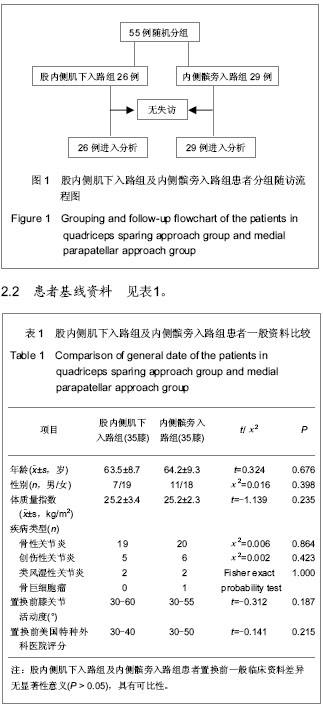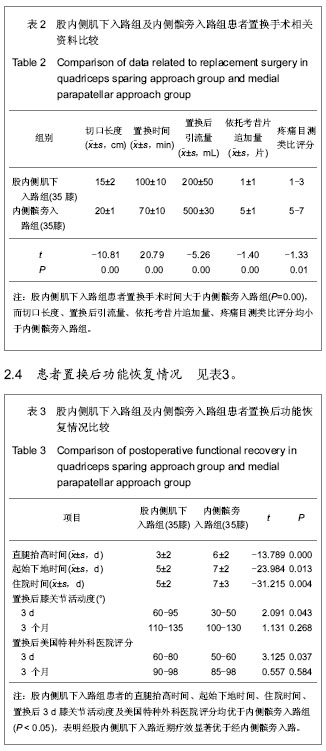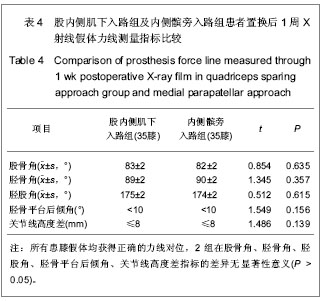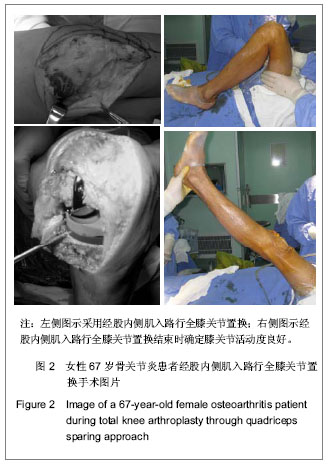| [1] 吴海山,吴宇黎.人工膝关节外科学[M].北京:人民军医出版社, 2006: 2.[2] Oikari M, Häkkinen A, Kautiainen H, et al. Referrals of knee osteoarthritis patients to orthopedic surgery. Duodecim. 2012;128(15):1593-1599. [3] Van der Helm-van Mil AH, Huizinga TW. The 2010 ACR/EULAR criteria for rheumatoid arthritis: do they affect the classification or diagnosis of rheumatoid arthritis? Ann Rheum Dis. 2012;71(10):1596-1598. [4] Massin P, Bonnin M, Paratte S, et al. Total knee replacement in post-traumatic arthritic knees with limitation of flexion. Orthop Traumatol Surg Res. 2011;97(1):28-33. [5] Saikia KC, Bhuyan SK, Borgohain M, et al. Giant cell tumour of bone: an analysis of 139 Indian patients. J Orthop Sci. 2011;16(5):581-588.[6] Tekin B, Unver B, Karatosun V. Expectations in patients with total knee arthroplasty.Acta Orthop Traumatol Turc. 2012; 46(3):174-180.[7] Holm B, Kristensen MT, Myhrmann L,et al. The role of pain for early rehabilitation in fast track total knee arthroplasty. Disabil Rehabil. 2010;32(4):300-306.[8] 宋兵华,孙俊英,石岩,等.小切口经股内侧肌入路行全膝关节置换术[J].临床骨科杂志,2008,11(3):198-201.[9] Han KY, Chae WY. The Position of Proximal Reference Point of Tibia Plateau for Correct Tibial Osteotomy in Total Knee Replacement: Prospective Randomized and 6 Years Follow-up Study. Knee Surg Relat Res. 2011;23(4):197-202.[10] Nam SW, Lee YS, Kwak JH, et al. A Comparison of the Clinical and Radiographic Results of Press Fit Condylar Rotating-Platform High-Flexion and Low Contact Stress Mobile Bearing Prosthesis in Total Knee Arthroplasty: Short term Results. Knee Surg Relat Res. 2012;24(1):7-13.[11] Schüttrumpf JP, Balcarek P, Sehmisch S, et al. Navigated cementless total knee arthroplasty medium-term clinical and radiological results. Open Orthop J. 2012;6:160-163.[12] Viganò R, Marega L, Breemans E, et al. A systematic literature review of the Profix in primary total knee arthroplasty. Acta Orthop Belg. 2012; 78(1):55-60. [13] Wang W, Geller JA, Kim A, et al. Factors affecting response rates to mailed preoperative surveys among arthroplasty patients. World J Orthop. 2012;3(1):1-4.[14] 徐应龙,赵劲民,李书振,等.全膝关节置换术股内侧肌入路与内侧髌旁入路比较的系统评价[J].中国循证医学杂志,2010,10(5): 585-591.[15] Li XG, Tang TS, Qian ZL, et al. Comparison of the mini-midvastus with the mini-medial parapatellar approach in primary TKA. Orthopedics. 2011;34(2):81.[16] Hofmann AA,Plaster RL,Murdock LE.Subvastus(southern) approach for primary total knee arthroplasty.Clin Orthop Relat Res. 1991;(269):70-77.[17] Von Langenbeek Z. Resection des kniegelenke. Verh Dtsch En Gesuech F Chir. 1879;7:23.[18] 刘军,孙振辉,田峥巍,等.股内侧肌下入路全膝关节置换术初步观察研究[J].中国矫形外科杂志,2008,16(9):649-652.[19] Goble EM,Justin DF. Minimally invasive total knee replacement principles and technique. Orthop Clin Nor Am. 2004;35(2):235-245.[20] Van Hemert WL, Senden R, Grimm B, et al. Early functional outcome after subvastus or parapatellar approach in knee arthroplasty is comparable. Knee Surg Sports Traumatol Arthrosc. 2011;19(6):943-951.[21] Kim JG, Lee SW, Ha JK, et al. The effectiveness of minimally invasive total knee arthroplasty to preserve quadriceps strength: a randomized controlled trial. Knee. 2011;18(6): 443-447.[22] 高辉,陈庆真.改良股肌下入路微创全膝关节置换术的临床应用[J].中华临床医师杂志,2011,5(15):4427-4431.[23] In Y,Kim JM,Choi NY,et al. Large thigh girth is a relative contraindication for the subvastus approach in primary total knee arthroplasty. J Arthroplasty. 2007;22(4):569-573.[24] Teng Y, Du W, Jiang J, et al. Subvastus versus medial parapatellar approach in total knee arthroplasty: meta-analysis. Orthopedics. 2012;35(12):e1722-1731.[25] Bourke MG, Sclavos EK. A comparison of patellar vascularity between the medial parapatellar and subvastus approaches in total knee arthroplasty. J Arthroplasty. 2012;27(6):1123- 1127.[26] Dutka J, Skowronek M, Sosin P, et al. Subvastus and medial parapatellar approaches in TKA: comparison of functional results. Orthopedics. 2011;34(6):148. [27] Schroer WC, Diesfeld PJ, Reedy ME, et al. Mini-subvastus approach for total knee arthroplasty. J Arthroplasty. 2008; 23(1):19-25.[28] Niki Y, Mochizuki T, Momohara S, et al. Is minimally invasive surgery in total knee arthroplasty really minimally invasive surgery? J Arthroplasty. 2009;24(4):499-504.[29] Turajane T, Larbpaiboonpong V, Kongtharvonskul J, et al. Results of computer assisted mini-incision subvastus approach for total knee arthroplasty. J Med Assoc Thai. 2009; 92(Suppl 6):S51-58.[30] Bonutti PM, Zywiel MG, McGrath MS, et al. Surgical techniques for minimally invasive exposures for total knee arthroplasty. Instr Course Lect. 2010;59:83-91. [31] Pan WM, Li XG, Tang TS, et al.Mini-subvastus versus a standard approach in total knee arthroplasty: a prospective, randomized, controlled study. J Int Med Res. 2010;38(3): 890-900.[32] Schroer WC,Diesfeld PJ,Eeedy ME,et al. Evaluation of complications associated with six hundred min-subvastus total knee arthroplasties. J Bone Joint Surg Am. 2007;89(3): 76-81.[33] 沈灏,张先龙,蒋垚,等.微创全膝关节置换术中不干扰股四头肌和经股内侧肌入路的比较[J].中华关节外科杂志,2007,1(3):172- 176.[34] Van Hemert WL, Senden R, Grimm B, et al. Early functional outcome after subvastus or parapatellar approach in knee arthroplasty is comparable. Knee Surg Sports Traumatol Arthrosc. 2011;19(6):943-951.[35] Maffulli GD, Bridgman S, Maffulli N. Early functional outcome after subvastus or parapatellar approach in knee arthroplasty is comparable. Knee Surg Sports Traumatol Arthrosc. 2012; 20(9):1883-1884.[36] 胡健,蒋矗.全膝关节置换术入路选择探讨[J].国际骨科学杂志, 2010,31(2):95-96.[37] De Keyser W, Beckers L. Influence of patellar subluxation on ligament balancing in total knee arthroplasty through a subvastus approach. An in vivo study.Acta Orthop Belg. 2010; 76(6):799-805.[38] 刘军,孙振辉,田峥巍,等.股内侧肌下入路全膝关节置换术初步观察研究[J].中国矫形外科杂志,2008,16(9):649-652.[39] Benazzo F, Rossi SM.The trivector approach for minimally invasive total knee arthroplasty: a technical note. J Orthop Traumatol. 2012;13(3):159-162.[40] Tria AJ. Minimally invasive total knee arthroplasty: past,present,and future. Am J Orthop. 2007;36(9):6-7. |






